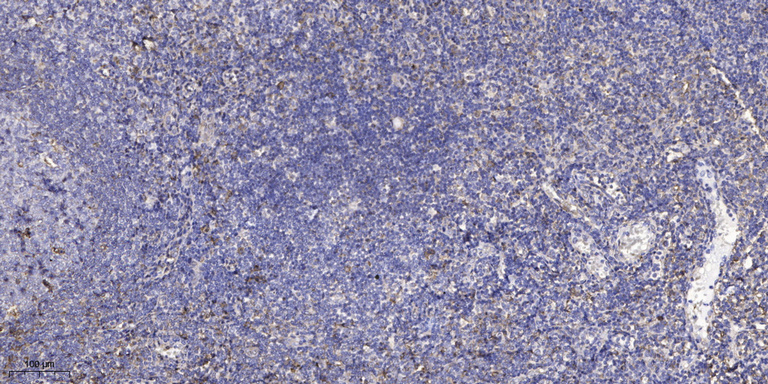Puratrophin 1 Polyclonal Antibody
- Catalog No.:YT3908
- Applications:WB;IHC;IF;ELISA
- Reactivity:Human;Monkey
- Target:
- Puratrophin 1
- Gene Name:
- PLEKHG4
- Protein Name:
- Puratrophin-1
- Human Gene Id:
- 25894
- Human Swiss Prot No:
- Q58EX7
- Immunogen:
- The antiserum was produced against synthesized peptide derived from human PLEKHG4. AA range:654-703
- Specificity:
- Puratrophin 1 Polyclonal Antibody detects endogenous levels of Puratrophin 1 protein.
- Formulation:
- Liquid in PBS containing 50% glycerol, 0.5% BSA and 0.02% sodium azide.
- Source:
- Polyclonal, Rabbit,IgG
- Dilution:
- WB 1:500 - 1:2000. IHC 1:100 - 1:300. ELISA: 1:20000.. IF 1:50-200
- Purification:
- The antibody was affinity-purified from rabbit antiserum by affinity-chromatography using epitope-specific immunogen.
- Concentration:
- 1 mg/ml
- Storage Stability:
- -15°C to -25°C/1 year(Do not lower than -25°C)
- Other Name:
- PLEKHG4;PRTPHN1;Puratrophin-1;Pleckstrin homology domain-containing family G member 4;PH domain-containing family G member 4;Purkinje cell atrophy-associated protein 1
- Observed Band(KD):
- 135kD
- Background:
- The protein encoded by this gene can function as a guanine nucleotide exchange factor (GEF) and may play a role in intracellular signaling and cytoskeleton dynamics at the Golgi apparatus. Polymorphisms in the region of this gene have been found to be associated with spinocerebellar ataxia in some study populations. Alternative splicing results in multiple transcript variants. [provided by RefSeq, Jan 2015],
- Function:
- disease:Defects in PLEKHG4 are the cause of spinocerebellar ataxia 16q22-linked (SCA16q22) [MIM:117210]; alo known as pure spinocerebellar ataxia Japanese type or SCA4 pure Japanese type. Spinocerebellar ataxia is a clinically and genetically heterogeneous group of cerebellar disorders. Patients show progressive incoordination of gait and often poor coordination of hands, speech and eye movements, due to degeneration of the cerebellum with variable involvement of the brainstem and spinal cord. SCA16q22 belongs to the autosomal dominant cerebellar ataxias type III (ADCA III) which are characterized by pure cerebellar ataxia without additional signs.,function:Possible role in intracellular signaling and cytoskeleton dynamics at the Golgi.,similarity:Contains 1 DH (DBL-homology) domain.,similarity:Contains 1 PH domain.,tissue specificity:Expressed in kidney, Leydig cells in the testis, epit
- Expression:
- Expressed in kidney, Leydig cells in the testis, epithelial cells in the prostate gland and Langerhans islet in the pancreas. Isoform 1 and isoform 3 are strongly expressed in Purkinje cells and to a lower extent in other neurons (at protein level). Widely expressed at low levels. More strongly expressed in testis and pancreas.
- June 19-2018
- WESTERN IMMUNOBLOTTING PROTOCOL
- June 19-2018
- IMMUNOHISTOCHEMISTRY-PARAFFIN PROTOCOL
- June 19-2018
- IMMUNOFLUORESCENCE PROTOCOL
- September 08-2020
- FLOW-CYTOMEYRT-PROTOCOL
- May 20-2022
- Cell-Based ELISA│解您多样本WB检测之困扰
- July 13-2018
- CELL-BASED-ELISA-PROTOCOL-FOR-ACETYL-PROTEIN
- July 13-2018
- CELL-BASED-ELISA-PROTOCOL-FOR-PHOSPHO-PROTEIN
- July 13-2018
- Antibody-FAQs
- Products Images

- Western blot analysis of lysates from COS7 and K562 cells, using PLEKHG4 Antibody. The lane on the right is blocked with the synthesized peptide.

- Western blot analysis of the lysates from HUVECcells using PLEKHG4 antibody.

- Immunohistochemical analysis of paraffin-embedded human tonsil. 1, Antibody was diluted at 1:200(4° overnight). 2, Tris-EDTA,pH9.0 was used for antigen retrieval. 3,Secondary antibody was diluted at 1:200(room temperature, 30min).



